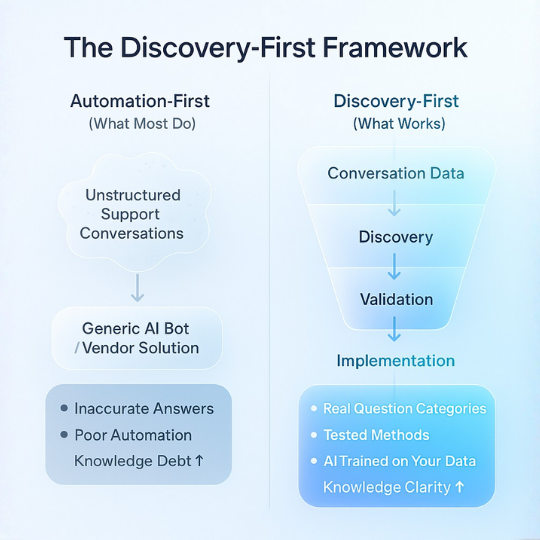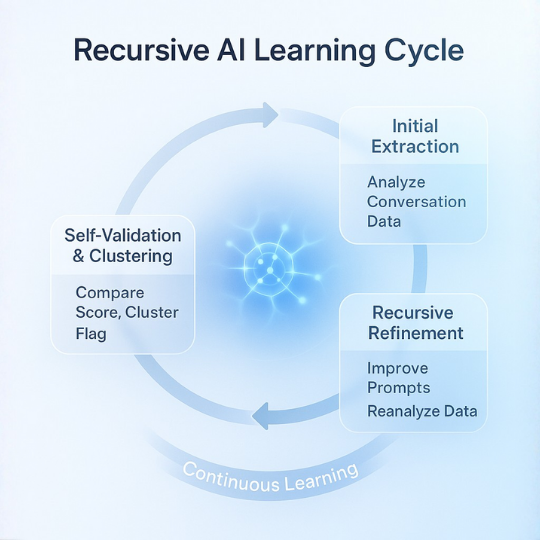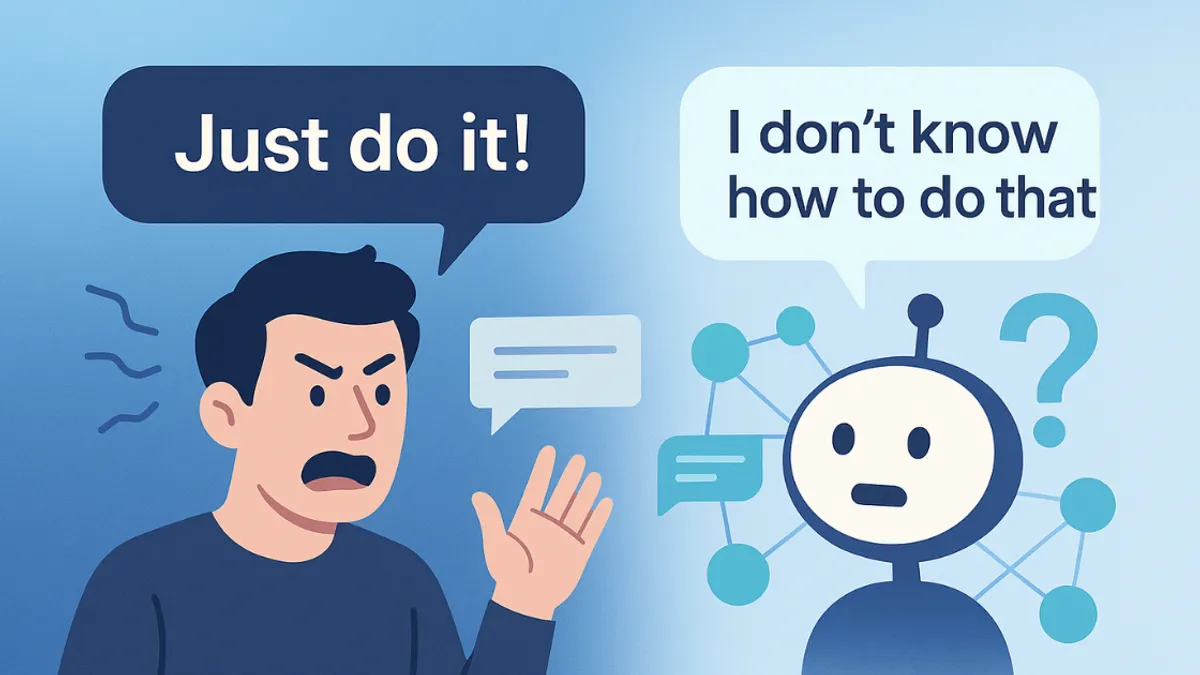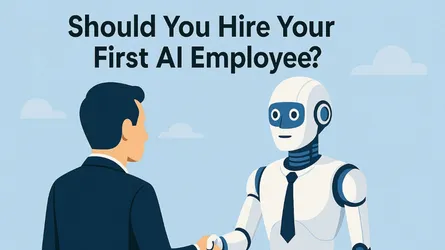Quick question: Can you list the top 10 questions your customers ask your support team? Not the questions you think they ask—the actual, data-backed top 10.
If you can’t answer confidently, you have knowledge debt. And it’s compounding every single day.
The Discovery-First Framework
At Infinite Automation, we realized a fundamental truth: you can’t automate what you don’t understand, and you can’t improve what you can’t see.
Most businesses rush to implement AI chatbots without knowing what their customers actually ask. They feed unstructured conversation data into AI systems and wonder why results disappoint. The problem isn’t the AI—it’s the lack of systematic discovery before automation.
The Three-Phase Approach
Phase 1: Discovery - Understand what customers are actually asking. Identify question categories, measure frequency distribution, and map patterns across conversations. This creates your knowledge landscape—what matters most and why.
Phase 2: Validation - Test extraction methods before scaling. Use systematic prompt experimentation, multi-model AI comparison, and human-in-the-loop quality assessment. Learn what works on YOUR data specifically, not what’s trendy.
Phase 3: Implementation - Build systems backed by evidence, not guesswork. Prioritize knowledge base content by actual demand. Train AI on validated methods. Deploy with confidence because you understand what you’re automating.

The difference between AI that works and AI that frustrates? The working AI was trained on YOUR customers’ actual questions, not a vendor’s assumptions.
Why This Works
Traditional approaches fail because they skip discovery. They assume you know what to automate, or worse, they let generic AI “figure it out.” But generic solutions can’t deliver specific results.
Discovery-first treats customer data as research material before automation input. You systematically understand patterns, validate extraction approaches, then scale with confidence. Every decision is backed by data from YOUR customer conversations, not industry generalizations.
The framework works because it builds on understanding, not assumptions. When you know what customers ask, how often, and what business value each question type represents, you can prioritize effectively. Your knowledge base addresses real needs. Your AI trains on actual patterns. Your automation solves problems that actually exist.
The Recursive AI Learning Approach
The traditional approach—manually reading hundreds of conversations—is time-consuming and doesn’t scale. Advanced AI systems can extract, validate, and refine insights automatically through recursive learning cycles.
Here’s how the process works:
Phase 1: Initial Extraction
AI analyzes conversation batches to identify themes, questions, and patterns. It extracts:
- Question categories and frequencies
- High-value signals (purchase intent, urgent issues, feature requests)
- Edge cases and unusual patterns
- Semantic relationships between topics

Phase 2: Self-Validation & Clustering
The AI validates its own extraction quality by:
- Clustering similar questions to identify themes
- Cross-referencing findings across conversation batches
- Scoring confidence levels for each identified pattern
- Flagging inconsistencies for review
This creates a “ground truth” dataset—validated patterns from actual conversations.
Phase 3: Recursive Refinement
Using validated patterns, the AI:
- Refines extraction prompts based on what worked
- Re-analyzes conversations with improved understanding
- Tests multiple extraction strategies in parallel
- Continuously improves accuracy through iteration
Each cycle makes the AI smarter about YOUR specific customer language, question patterns, and business context.
The challenge: Building these recursive learning systems requires AI expertise, validation frameworks, and systematic prompt engineering. it’s not a one-size fits all and most SAAS platforms offering customer service bots offer only basic learning models.
The Path Forward
Training AI systems isn’t about having the right technology—it’s about having the right process. By treating customer data analysis as a discovery problem first, you build systems that actually work because they’re built on understanding, not assumptions.

You can’t automate what you don’t understand. Discovery-first AI systems outperform black box solutions every time.
Take Control of Your Customer Intelligence
At Infinite Automation, we specialize in turning unstructured customer data into strategic intelligence. Our discovery-first framework extracts insights from historical conversations, enabling data-driven knowledge bases and AI deployments built on actual customer patterns—not vendor assumptions.
Ready to Close Your Knowledge Debt?
📊 Free Knowledge Base Audit: Understand what your customers are actually asking before you build anything. We’ll analyze a sample of your conversations and show you the patterns you’re missing.
Learn more about our AI implementation services and how we help businesses rethink their approach to AI.
💬 Question for you: How many customer conversations has your business accumulated? When’s the last time someone systematically analyzed them?


